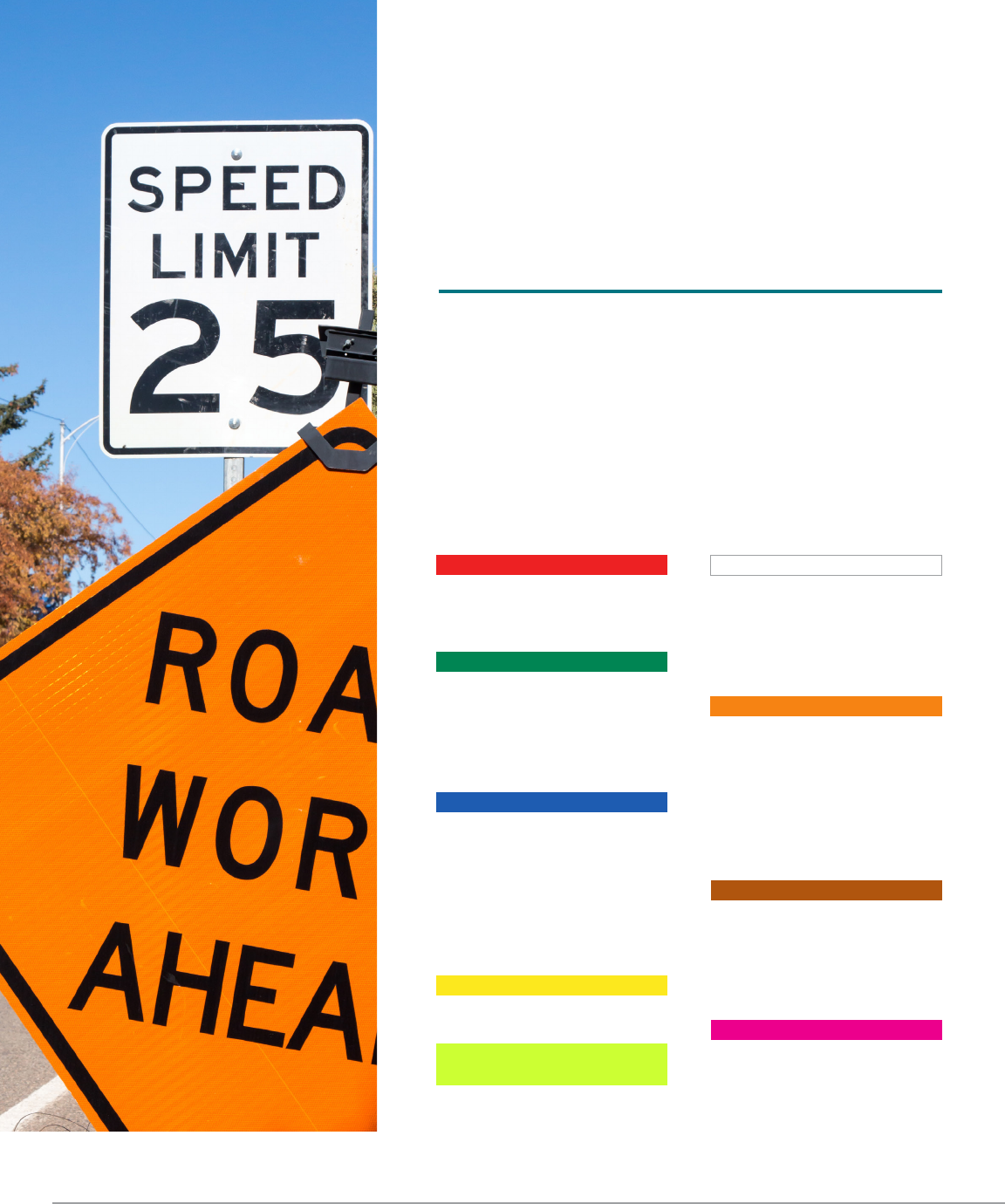
PAGE
6
CHAPTER 2
TRAFFIC SIGNS
& RULES OF
THE ROAD
2.1 TRAFFIC SIGNS
Trafc signs advise of trafc laws, hazards, location, directions,
and where services are located. The shape and color of trafc
signs give clues to the type of information they provide.
STANDARD COLORS
RED
Stop, yield, or do what is
shown on the sign.
GREEN
Direction. Indicates where
a place is, or how far a
place is from where you
are.
BLUE
Services for travelers.
Directs you to places such
as rest areas, tourist sites,
hospitals, lodging, fuel
stations, restaurants, and
tourist attractions.
YELLOW
General warning.
FLUORESCENT
YELLOW
-
GREEN
Pedestrian, bicycle, and
school warning signs.
WHITE
Regulatory. Provides
information regarding
enforceable laws and
ordinances.
ORANGE
Road work, temporary
trafc control, and
maintenance warnings. Be
sure to watch for changing
speed limits and workers
on the road.
BROWN
Recreation and cultural
points of interest. Provides
direction to historical sites,
parks, or recreational areas.
FLUORESCENT PINK
Warning and guide signs
for incident management
such as crash clean up,
debris removal, etc.
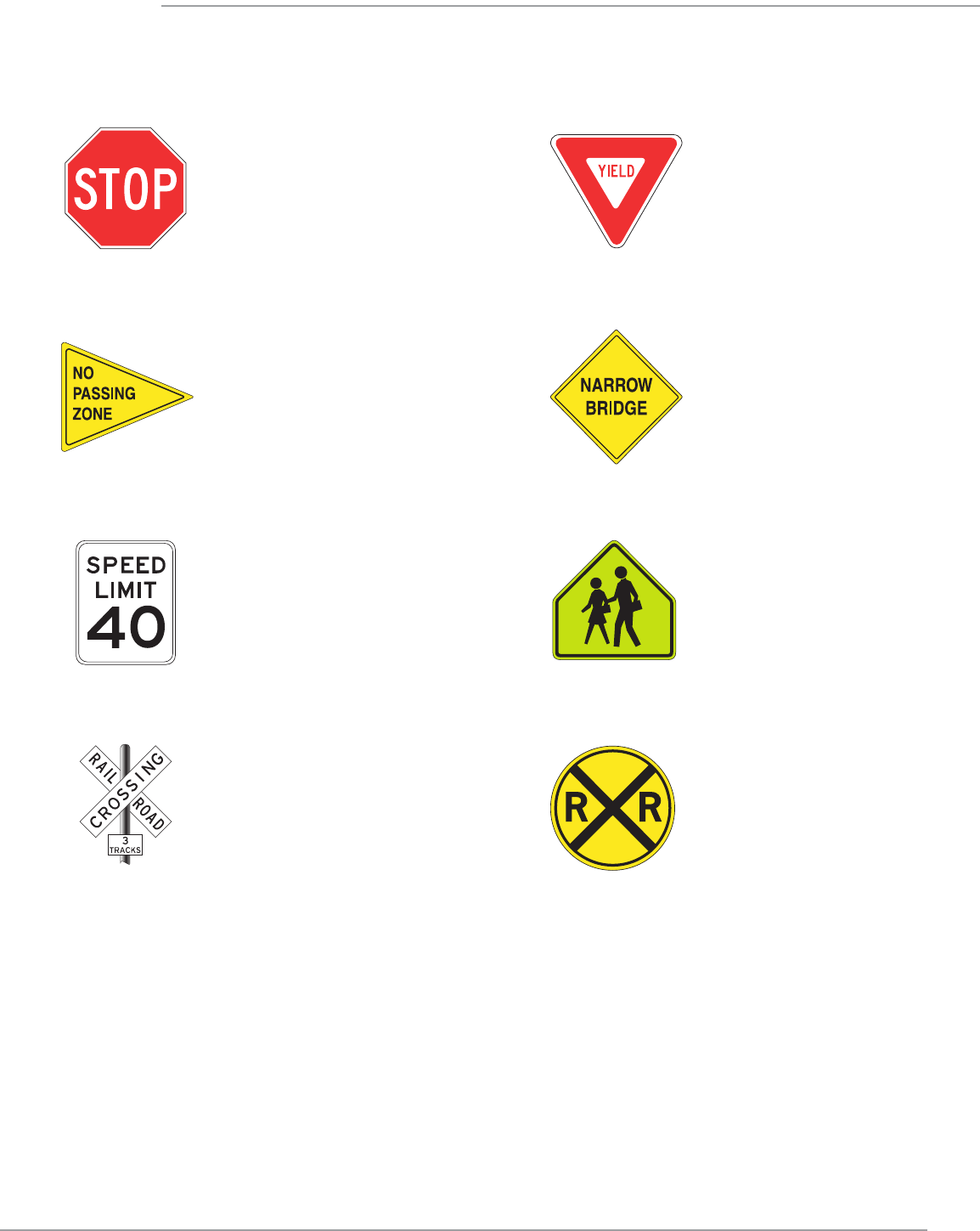
PAGE
7
CHAPTER 2
STANDARD SHAPES
OCTAGON
Shape is reserved for a stop sign
only. Come to a full stop at an
intersection controlled by this sign.
EQUILATERAL TRIANGLE
Yield the right of way.
PENNANT
This sign will be on the left side
of the road. It warns you of a no
passing zone.
DIAMOND
Warning. Alerts you to special road
hazards. Words or pictures on the
sign will show you why you need
to slow down or use extra caution.
RECTANGLE
Is used for regulatory, guide, and
warning signs.
PENTAGON
School crossing. Signs mark school
areas and school crossings.
CROSSBUCK
Railroad crossing signs are placed at
each crossing. A number sign under
the crossbucks shows how many
sets of train tracks you must cross.
CIRCLE
Railroad crossing ahead.
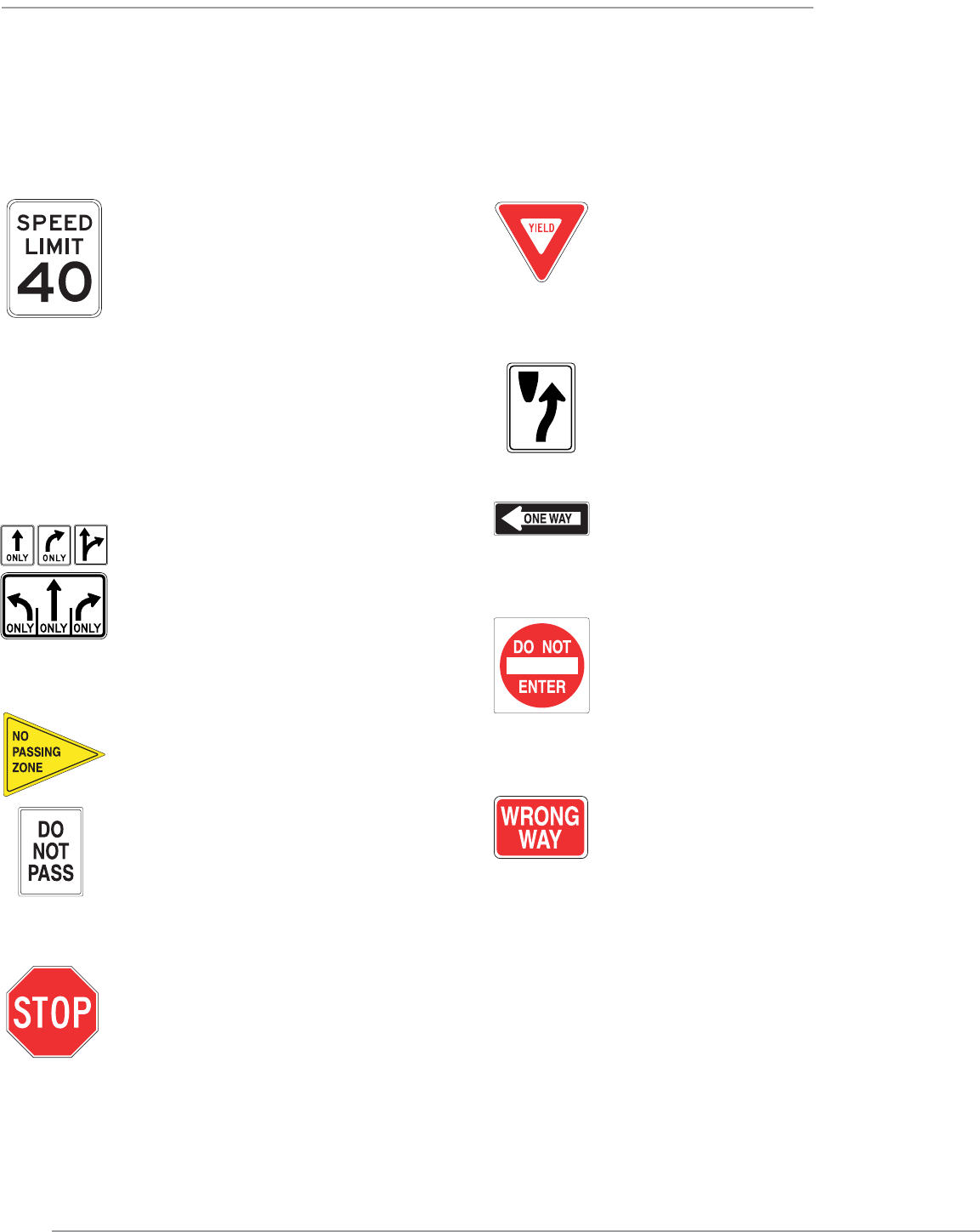
PAGE
8
CHAPTER 2
2.2 REGULATORY SIGNS
These signs provide information about rules for trafc direction, lane use, turning, speed, parking, and other special
situations. Some regulatory signs have a red circle with a red slash over a symbol. These indicate you cannot do
something; for example, no left turn, no right turn, or no U-turn.
SPEED LIMIT SIGNS
Speed limit signs indicate the maximum
or minimum safe speed that is allowed.
Maximum speed limits are for ideal
driving conditions. Sometimes you must
reduce your speed when conditions
require it, such as when the roadway
is slippery (during rain or snow) or it is
difcult to see clearly down the road
(during fog). Some high-speed roads
have minimum speed limits. If this
minimum speed is too fast for you, then
you should use another route.
LANE CONTROL SIGNS
These signs mark where you can go
and where you can turn, and often use
an arrow symbol. The signs are along
the road or hanging over the road.
Sometimes white arrows may also be
painted on the road.
NO PASSING SIGNS
These signs mark where it is not safe
to pass another vehicle. The no passing
zone sign is located at the beginning of
the no passing zone. Passing areas are
based on how far you can see ahead.
Where passing is allowed, you may do
so only if it is safe. No passing zone
pavement markings are described on
page 44.
STOP SIGN
A stop sign means you must come
to a full stop and wait until crossing
vehicles and pedestrians have
cleared before proceeding. Stop at
the stop line if one is present. If
necessary, you may then pull forward
to the stop sign or the edge of
the intersection and then proceed when
it is safe to do so.
YIELD SIGN
A yield sign means you must slow down
and yield the right of way to trafc in
the intersection you are crossing or
roadway you are entering.
DIVIDED HIGHWAY
The road ahead is divided. This sign
directs traffic around an island or
barrier.
ONE
-
WAY
Trafc moves only in the direction of
the arrow.
DO NOT ENTER SIGN
You will see this sign at roadway
openings you are not to enter. You will
see them at exit ramps, in crossovers
on divided roadways, and at numerous
locations on one-way roads.
WRONG WAY
You made a wrong turn and have
entered a lane of oncoming trafc.
Remove your vehicle from the traveled
portion of the road and get stopped and
turned around as quickly and safely as
possible.

PAGE
9
CHAPTER 2
2.3 WARNING SIGNS
Warning signs are yellow with black lettering or symbols and most are diamond-shaped. These signs warn you to
slow down and be prepared to stop if necessary; a special situation or hazard is ahead. Some common warning signs
are shown below.
INTERSECTION/
CROSSROAD
There is another road
ahead that crosses the
road you are on. Watch
carefully for cross trafc
in your path.
SIGNAL AHEAD
These signs are used
on roads with higher
speeds. Be ready for an
intersection and a stop
light.
MERGING TRAFFIC
If you are on the main
road and see this sign, be
prepared for other vehicles
blending into your lane.
TWO
-
WAY TRAFFIC
Keep to the right because
you are leaving a one-way
road and entering a two-
way road.
DIVIDED HIGHWAY
BEGINS
You are getting close to
the place where two-way
trafc will be divided by a
center strip.
DIVIDED HIGHWAY
ENDS
Two-way trafc will no
longer be divided by a
center strip. Watch out for
oncoming vehicles.
HORSE
-
DR AWN
VEHICLE
Be alert for slow-moving,
horse-drawn vehicles on
the roadways. Reduce your
speed and pass slowly.
LANE ENDS
Two lanes of trafc will
soon become one lane of
trafc. Trafc must yield
when merging.
FARM MACHINERY
Be alert for slow-moving,
farm equipment on the
roadways. Reduce your
speed and pass slowly.
PEDESTRIAN CROSSING
Watch out for people who
might walk or run in front
of your vehicle.
DEER CROSSING
There may be deer trying
to cross the roadway in the
area. Slow down and watch
carefully.
HILL
This sign is a warning to
all vehicles that the road
ahead goes down a hill. You
should check your brakes
before going down the hill.
T
-
INTERSECTION AHEAD
The road you are on does
not go straight ahead.
Prepare to turn right or left.
SCHOOL BUS
STOP AHEAD
You are nearing an area
where a stopped school
bus will pick up or drop
off passengers. Watch for
children. Be prepared to stop.
GRADUAL CURVE
Road ahead curves
gradually. Be prepared
for the change in
direction.
SLIPPERY WHEN WET
Road ahead becomes
slippery in wet weather.
Slow down under these
conditions.
CHEVRON SIGN
Used in addition to the
curve signs when there
is a need to draw added
attention to a change in
the road’s direction.
RAMP SPEED
The recommended
speed on an exit ramp.
ADVANCE SCHOOL
CROSSING
You are nearing a school
area with a crossing.
Watch for children and
the marked school
crossing. The color of
this sign may be yellow.
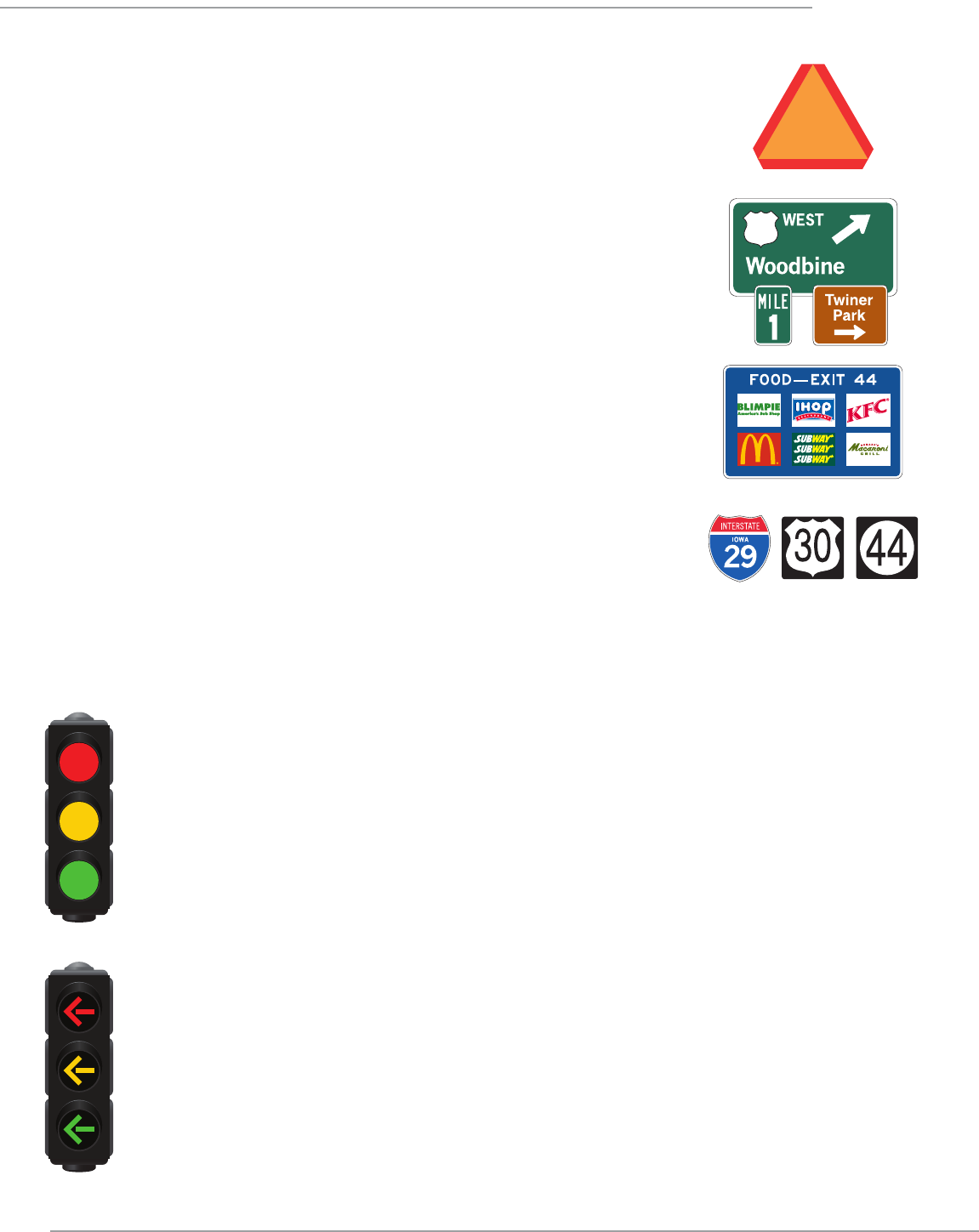
PAGE
10
CHAPTER 2
Solid red
Come to a complete stop.
Flashing red
Treat it the same as a stop sign.
Solid yellow
Do not enter the intersection if you can stop
safely. If you cannot stop safely, proceed
through the intersection with caution.
Flashing yellow
Proceed with caution. Yield to vehicles and
pedestrians and proceed when it is safe.
Solid green
Go, but only when the intersection is clear.
Yield to vehicles and pedestrians in the
intersection. When the light changes, trafc
may be caught in the intersection, and you
must give them time to clear.
Steady red arrow
Drivers turning left or right must stop.
Steady yellow arrow
The left or right turn signal is about to turn
red. Do not enter the intersection if you can
stop safely. Complete your left or right turn
if you are already within the intersection.
Flashing yellow arrow
Yield to oncoming trafc and pedestrians;
then turn left proceeding with caution.
Oncoming trafc has a green light.
Steady green arrow
Drivers can proceed with the left or right
turn. Oncoming trafc must stop. Do not
go straight. Drive only in the direction of
the arrow. Yield the right of way to other
vehicles and pedestrians already in the
intersection.
2.4 S LOW
-
MOVING VEHICLE SIGN
A reective orange triangle on the rear of a vehicle means it is traveling 35 mph or
less. You may see this sign on road maintenance equipment, farm vehicles, or horse-
drawn wagons.
2.5 GUIDE SIGNS
Guide signs show directions and distance to various locations, or areas such as cities,
airports, state lines; or to places of interest such as national parks, historical areas,
or museums. Mile markers show the number of miles from where the Interstate route
entered the state you are traveling in. They can be used to calculate how far you are
from your exit or destination and give your exact location in an emergency.
2.6 SERVICE SIGNS
Service signs show the location of various services; such as rest areas, fuel stations,
campgrounds, or hospitals.
2.7 RO U T E SIG N S
The shape of a route sign indicates the type of roadway it is - interstate, U.S. highway,
Iowa route, county road, etc. During a trip, follow the signs to stay on your route.
2.8 TRAFFIC SIGNALS
In addition to trafc signals, trafc control can be provided by law enforcement, highway personnel, or school
crossing guards. You must follow directions from these persons.
30
Standard trafc signal
Arrow signal head
Interstate U.S.
Highway
Iowa
Route
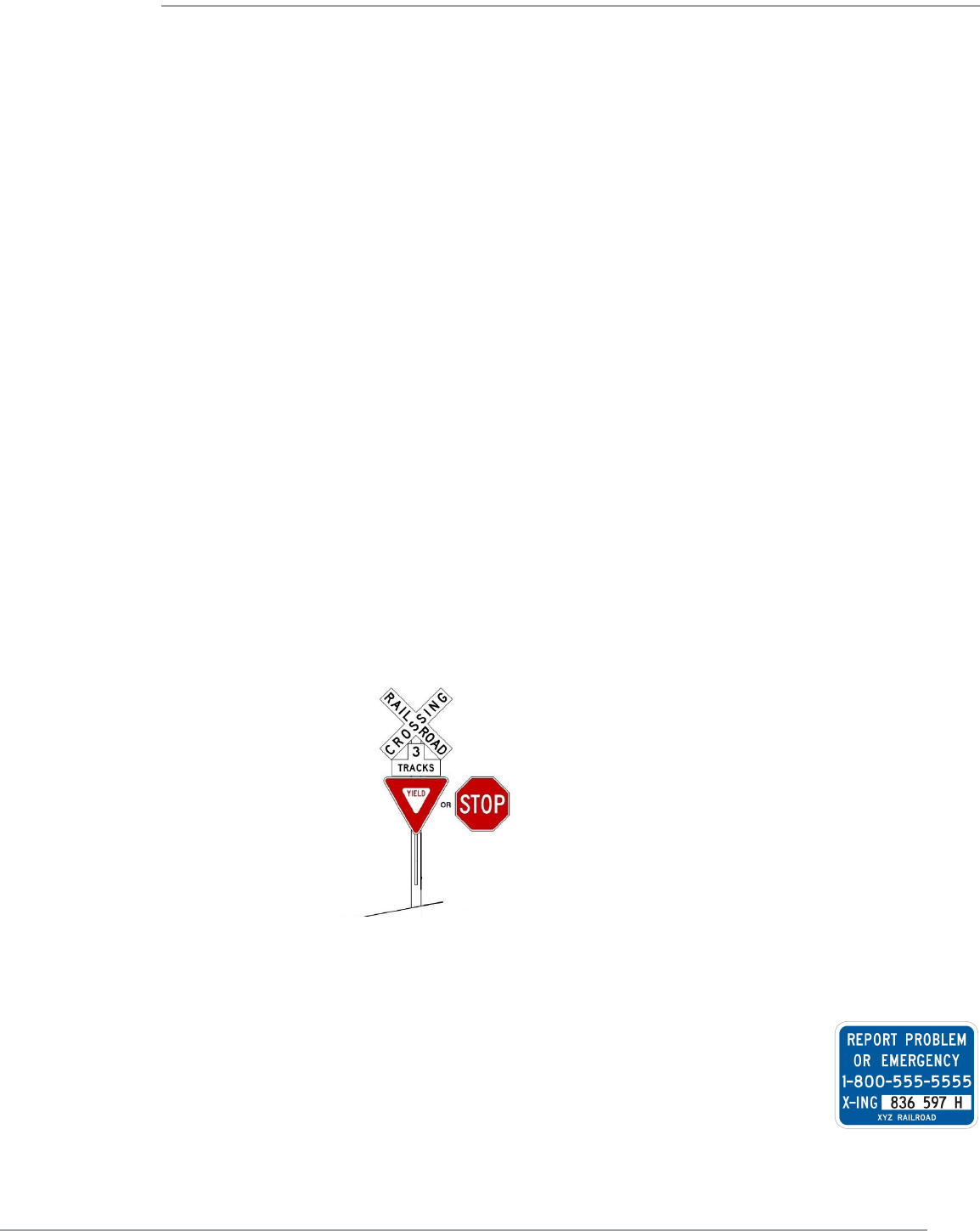
PAGE
11
CHAPTER 2
2.9 RAILROAD CROSSINGS
Use extra caution at railroad crossings and never stop
your vehicle on the railroad tracks. Trains cannot stop
quickly.
Advance warning signs and pavement markings
indicate railroad tracks cross the road ahead. As you’re
approaching tracks, eliminate distractions, put your
windows down, and turn off your music. See gure 2.1
for common railroad crossing signs and signals.
Highway-railroad crossings have the name of
the railroad and a number to call posted in case
of emergency. If you become aware of a signal
malfunction or other dangerous situation (such as a
stalled vehicle, other obstruction, or track damage),
call the number posted to notify the appropriate
railroad (see bottom right image of ENS sign).
ACTIVELY PROTECTED
RAILROAD CROSSINGS
Actively protected railroad crossings are equipped
with lights and/or gates. If the lights are ashing
or gates are down, it means a train is approaching.
Always obey these warning signals. Do not cross
when lights are ashing or try to go around the gate.
PASSIVELY PROTECTED
RAILROAD CROSSINGS
Passively protected railroad crossings
do not have lights or gates. They will
only be marked with a crossbuck and
a stop or yield sign. At this type of
crossing, slow down and look for an
oncoming train. Do not rely on any
lights or gates, and always expect
a train.
REQUIRED TO STOP
All school buses, charter buses, drivers carrying
passengers for hire (such as Uber or Lyft), and all
vehicles required to be placarded for hazardous
materials, must stop within 15 to 50 feet of railroad
tracks before crossing. If a police ofcer or highway
trafc signal directs highway trafc to proceed, you do
not have to stop. You also do not have to stop if the
crossing is marked with an “EXEMPT” sign.
MAKE SAFE CHOICES
Source: Operation Lifesaver
Cross Legally & Safely
•
The only safe and legal place for anyone to cross
railroad tracks is at designated crossings.
• Obey warning signs and signals.
•
Not all train tracks have gates. Watch for
advance warning signs and pavement markings
indicating railroad tracks cross the road ahead.
•
Rail cars have reective stripes to enhance their
visibility at night and in other low visibility
environments, such as rain, snow, or fog. Be on
the lookout for these when conditions might
make it difcult to spot a train.
• Look for a train before proceeding.
Wait, Look Both Ways
• Always expect a train.
•
Trains may be closer and traveling faster than
they appear and can run on any track at any time.
•
Multiple tracks may mean multiple trains. Ensure
you can clearly see down the tracks in both
directions before proceeding.
• Avoid crossing while lights are ashing or gates
are down. Never try to beat a train
Avoid Getting Stuck
•
Before crossing, be sure you can completely clear
the tracks. Keep in mind that trains are wider
than the tracks.
•
When stopped, leave at least 15 feet between
the front and rear of your vehicle and the nearest
rail.
• Avoid shifting gears while crossing.
Get Out, Get Away, Find the Blue & White Sign
•
If your vehicle gets stuck or stalls at a crossing,
get everyone out and far away immediately, even
if you do not see a train.
•
Call the number on the
blue and white Emergency
Notication System (ENS)
sign. Share the crossing ID
number with the dispatcher.
• If there is no sign, call 911.
ENS sign
Passive Crossing Markings
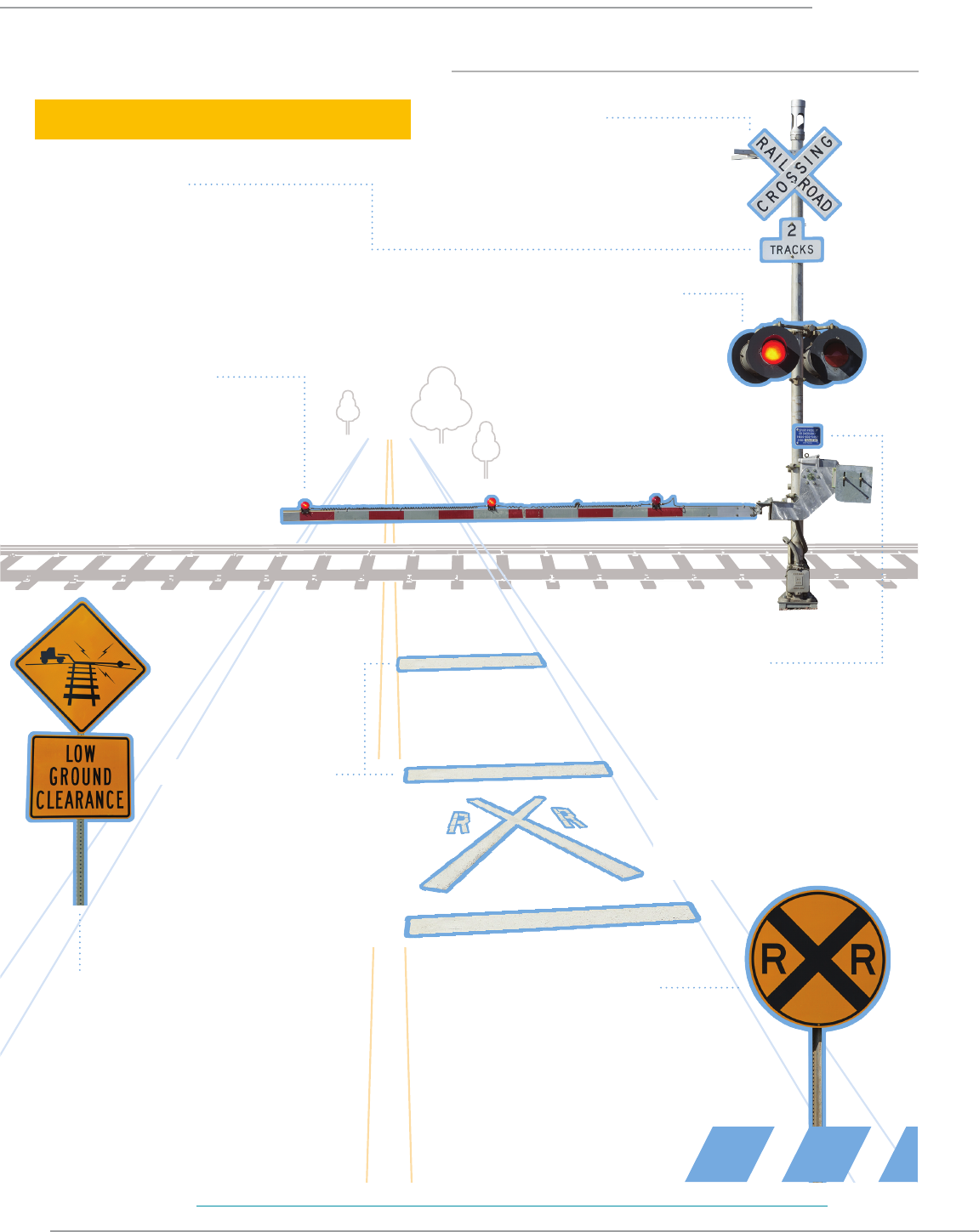
PAGE
12
CHAPTER 2
AVOID GETTING STUCK
Before crossing, be sure there is space
on the other side to completely clear
the tracks. Trains overhang tracks.
When driving leave at least 15 feet
between the front and rear of your
vehicle and the nearest rail. Avoid
shifting gears while crossing.
15’
MAKE SAFE CHOICES
GET OUT! GET AWAY!
FIND THE BLUE AND WHITE SIGN
If your vehicle gets stuck or stalls
at a crossing, get everyone out and
far away immediately, even if you
do not see a train. Call the number
on the Blue and White Emergency
Notication System (ENS) sign and
share the crossing ID number with the
dispatcher. No sign? Dial 911.
WAIT, LOOK BOTH WAYS
Always expect a train. Trains may be
closer and traveling faster than they
appear and can run on any track at
any time. Multiple tracks may mean
multiple trains. Ensure you can
clearly see down the tracks in both
directions before proceeding.
AVOID crossing while lights are
ashing or gates are down.
Never try to beat a train.
CROSS LEGALLY AND SAFELY
The only safe and legal place for
anyone to cross railroad tracks
is at designated crossings.
Always obey warning signs and
signals. Alw
ays look for a train
before proceeding.
LOWERING GATES AND
FLASHING RED LIGHTS
A train is approaching (even if you
A train is approaching (even if you
don’t see it yet). Do not proceed until
don’t see it yet). Do not proceed until
lights turn off and gates go up. It is
lights turn off and gates go up. It is
illegal and dangerous to go around
illegal and dangerous to go around
lowered gates.
lowered gates.
MULTIPLE TRACKS
Multiple tracks are present. Multiple tracks
Multiple tracks are present. Multiple tracks
may mean multiple trains. Wait until you can
may mean multiple trains. Wait until you can
see clearly down the tracks in both directions
see clearly down the tracks in both directions
before proceeding.
before proceeding.
PAVEMENT MARKINGS
RxR and a wide white line on the
RxR and a wide white line on the
roadway mean you are approaching
roadway mean you are approaching
a railroad crossing. Stay behind the
a railroad crossing. Stay behind the
white stop line while waiting for a
white stop line while waiting for a
train to pass. No stop line? Stop at
train to pass. No stop line? Stop at
least 15 feet from the nearest rail.
least 15 feet from the nearest rail.
LOW GROUND CLEARANCE CROSSING
Raised crossing ahead. If you drive anything
Raised crossing ahead. If you drive anything
low to the ground — like a lowboy, bus, truck,
low to the ground — like a lowboy, bus, truck,
sports car or trailer — you are at risk of getting
sports car or trailer — you are at risk of getting
hung up on the tracks. Do not proceed until
hung up on the tracks. Do not proceed until
you know your vehicle will clear the tracks.
you know your vehicle will clear the tracks.
FLASHING RED LIGHTS
STOP when ashing. DO
STOP when ashing. DO
NOT proceed until lights
NOT proceed until lights
stop ashing. If lights begin
stop ashing. If lights begin
ashing after you start across
ashing after you start across
the tracks, keep going.
the tracks, keep going.
CROSSBUCK
YIELD if a train is
YIELD if a train is
approaching. Trains always
approaching. Trains always
have the right-of-way.
have the right-of-way.
EMERGENCY NOTIFICATION
SYSTEM (ENS)
This is the rst phone number
This is the rst phone number
to call if a vehicle is stuck or
to call if a vehicle is stuck or
stalls on the tracks. NOTE: Each
stalls on the tracks. NOTE: Each
sign has a different phone number
sign has a different phone number
and location ID number.
and location ID number.
Also use the ENS to report people,
Also use the ENS to report people,
vehicles or debris on the tracks,
vehicles or debris on the tracks,
damaged signs or signals and
damaged signs or signals and
obstructed views.
obstructed views.
ADVANCE WARNING
Slow down, look, listen and be
Slow down, look, listen and be
prepared to stop. Typically, this
prepared to stop. Typically, this
is the rst sign you see when
is the rst sign you see when
approaching a railroad crossing.
approaching a railroad crossing.
KNOW THE SIGNS AND SIGNALS
Figure 2.1: Operation Lifesaver - Know the Signs and Signals
Source: Operation Lifesaver: https://oli.org/sites/default/les/2021-01/OLI_Brochure_All_Drivers_WEB_version.pdf
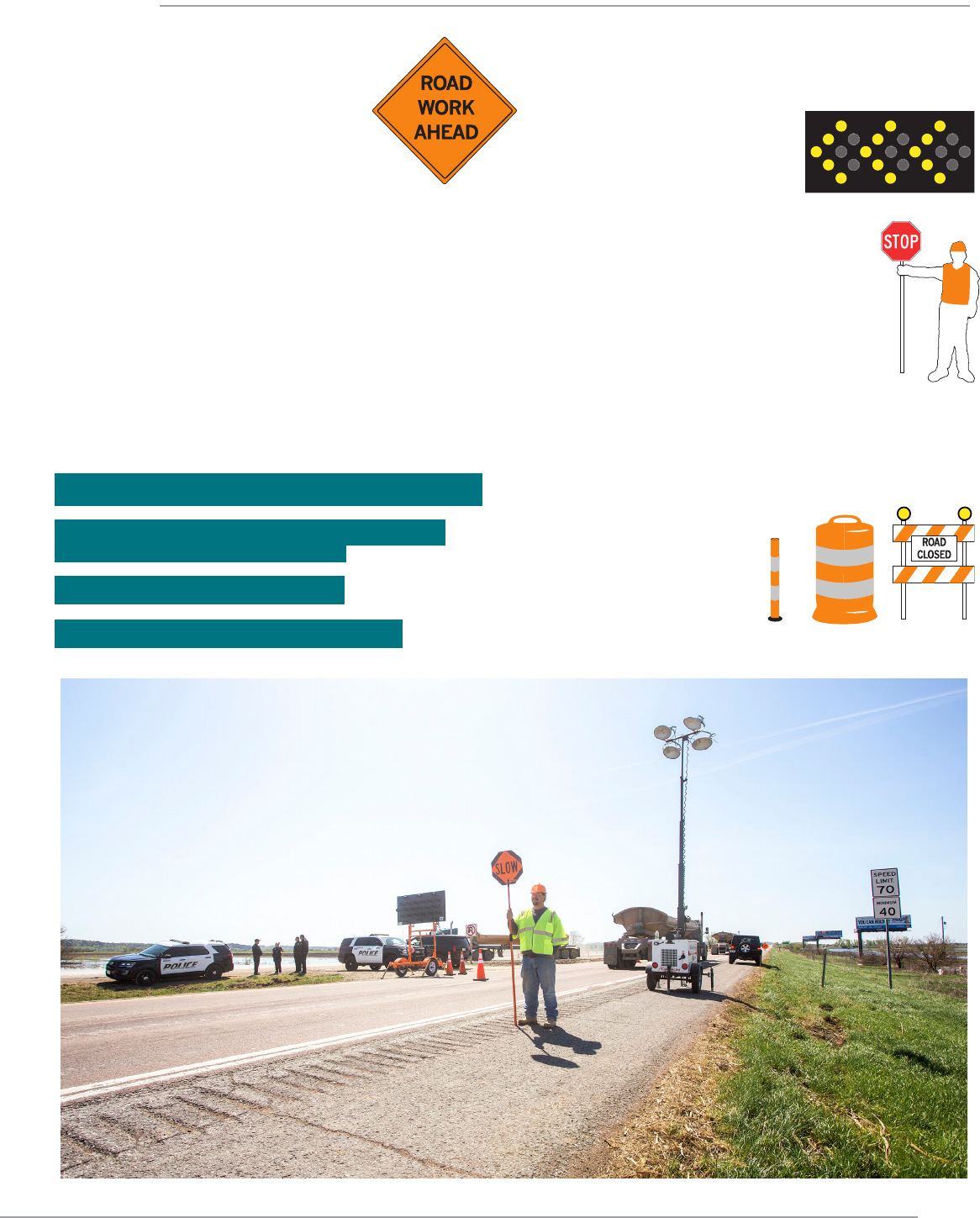
PAGE
13
CHAPTER 2
2.10 WORK ZONES
Trafc control devices such as arrow
boards, temporary traffic signals,
aggers, and channelizing devices are
added in work zones to make drivers aware of
different conditions. Most signs in work areas are
diamond-shaped, although a few signs are rectangular.
Orange is the basic color of these signs and warning
devices.
Trafc control devices and signs are used to mark
construction, maintenance, survey, and utility work
zones. These help direct drivers and pedestrians safely
through the work area while keeping it safe for workers
on the roadway. Stay alert and drive cautiously as nes
may double in work area zones.
Work zones can be dangerous, and road workers are
relying on you to keep them safe:
ADJUST YOUR SPEED TO THE TRAFFIC CONDITIONS.
OBEY ALL INSTRUCTIONS PROVIDED BY SIGNS,
TRAFFIC SIGNALS, AND FLAGGERS.
INCREASE FOLLOWING DISTANCE.
GIVE YOUR FULL ATTENTION TO DRIVING.
ARROW BOARDS
Large ashing arrow panels are
typically used when a lane or
shoulder is closed.
FLAGGERS
People with stop/slow paddles help
control trafc in work zones. Follow their
instructions. They should be wearing
uorescent yellow green or orange vests,
shirts or jackets. They will normally use
stop/slow signs. Red ags may be used
occasionally.
CHANNELIZING DEVICES
Barricades, vertical panels, drums, cones, and tubular
markers are the most common devices used to alert
drivers of unusual and potentially
dangerous conditions, and
to guide drivers safely
through the work zone.
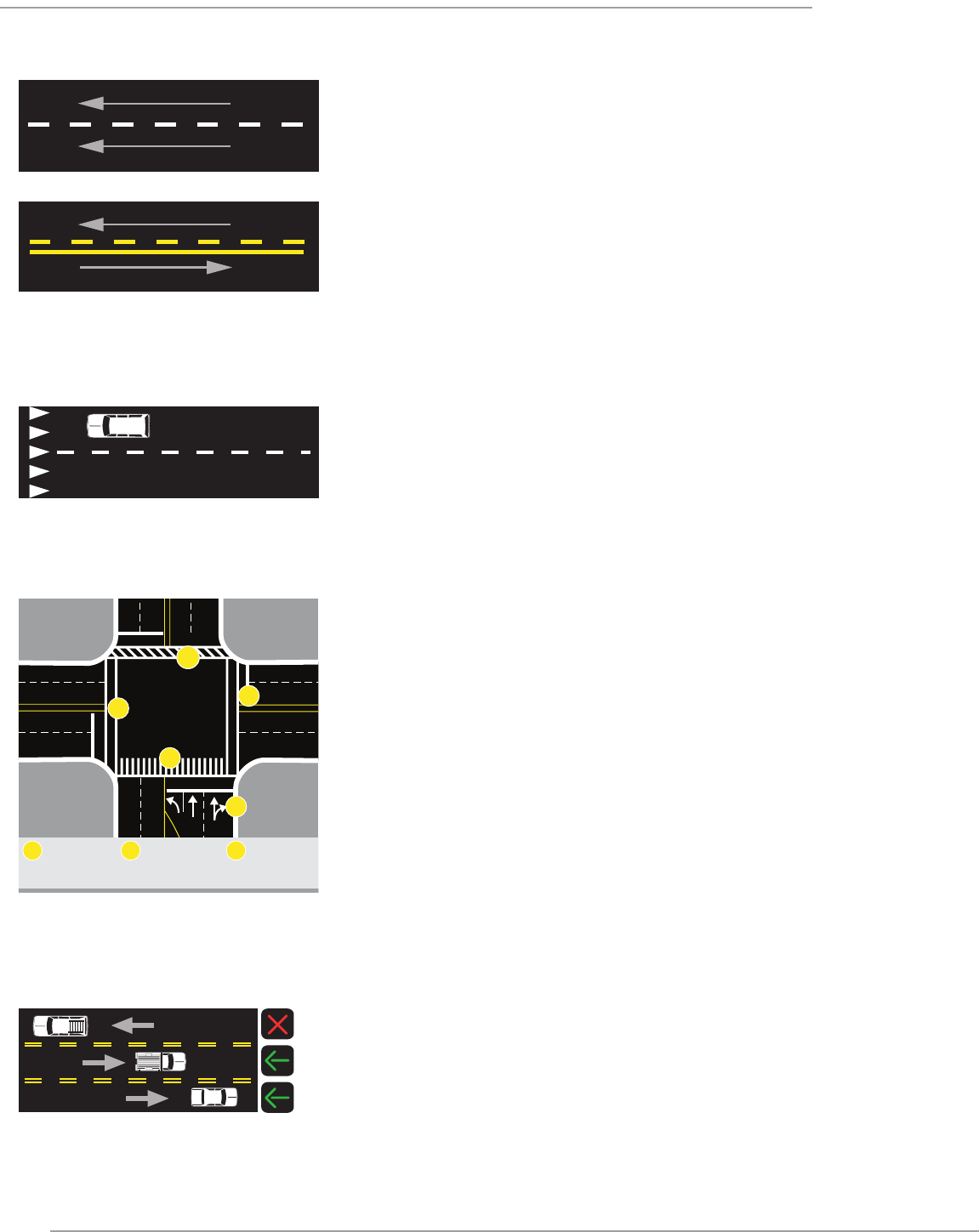
PAGE
14
CHAPTER 2
2.11 PAVEMENT MARKINGS AND OTHER
LANE CONTROLS
Pavement markings help direct and regulate trafc, just like highway
signs. You will nd them alone or used with signs and trafc signals.
White lines separate trafc moving in the same direction. Yellow lines
separate trafc moving in opposite directions.
On two-way roads you will see a solid yellow line with a dashed line
beside it in some places. Passing is not allowed on the side with the
solid yellow line. Vehicles on the side with the dashed line may pass
when safe to do so.
2.12 YIELD LINES
Yield lines consist of a row of solid white triangles pointing toward
approaching vehicles. These lines extend across a travel lane to indicate
the point where vehicles should yield in compliance with a “Yield” sign
or a “Yield Here To Pedestrians” sign.
2.13 CROSSWALKS, STOP LINES, AND
DIRECTIONAL ARROW MARKINGS
When required to stop because of a sign or signal, you must stop
before your vehicle reaches the stop line, or a crosswalk if there is
one. Crosswalks dene the area where pedestrians are to cross the
roadway. You must yield to pedestrians in or about to enter a crosswalk.
Not all crosswalks are marked. Be alert for pedestrians when crossing
intersections that do not have dened crosswalks.
Special arrow markings may be present and when used show the
movements that are allowed or required when driving in that lane.
2.14 REVERSIBLE LANES
Some travel lanes are designed to carry trafc in one direction at certain
times and in the opposite direction at other times. These lanes are
usually marked by double-dashed yellow lines. Before you start driving
in them, check to see which lanes you can use at that time. There may
be signs posted by the side of the road or overhead. Sometimes special
lights are used. A green arrow means you can use the lane beneath it;
a red “X” means you may not. A ashing yellow “X” means the lane is
only for turning. A steady yellow “X” means that the use of the lane is
changing and you should move out of it as soon as it is safe to do so.
A
B
C
C
C
Stop lines
A
Directional
arrow
markings
B
Different
types of
crosswalks
C
Figure 2.2: Lane control markings
Figure 2.3: Yield lines
Two-direction roadway
One-direction roadway
Figure 2.4: Crosswalk, stop lines,
and directional arrow markings
Figure 2.5: Reversible lanes
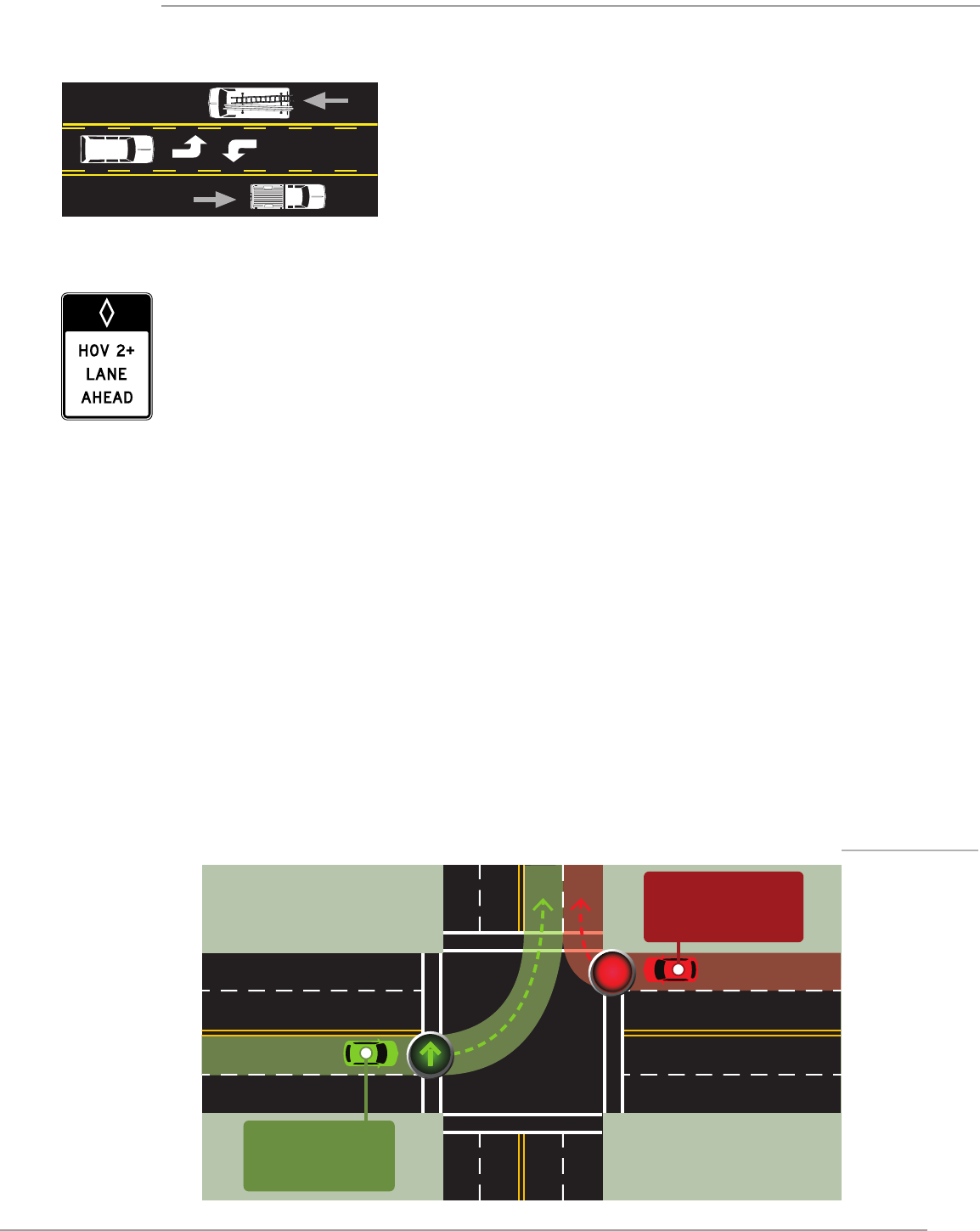
PAGE
15
CHAPTER 2
Figure 2.6: Shared left-turn lane
Figure 2.7: Reserved lane sign
In this example, the lane is
reserved for high-occupancy
vehicles (HOV) carrying two or
more people.
2.15 SHARED LEFT
-
TURN LANE
Shared left-turn lanes are reserved for vehicles making left turns from
either direction. On the pavement, left-turn arrows for trafc in one
direction alternate with left-hand arrows for trafc coming from the
other direction. These lanes are marked on each side by a solid yellow
and dashed yellow line. Vehicles may enter and stop in the lane before
making a left turn, but the lane cannot be used for passing.
2.16 RESERVED LANES
On various roadways one or more lanes may be reserved for special
vehicles. Reserved lanes are marked by signs stating that the lane is
reserved for special use, and often have a white diamond posted at the
side of the road and/or painted on the road surface. Do not travel in one
of these lanes unless operating that type of vehicle.
2.17 GENERAL LANE USE
•
On a road with two or more lanes traveling in the same direction, the left lane is generally used for passing.
On a road with three or more lanes stay in the right or center lane except to pass. If there is a lot of entering
trafc, it’s best to use the center lane.
• Unless instructed to do so by a trafc control device or an ofcial, never drive on the shoulder of the road.
• Never pass on the shoulder, whether it is paved or not. Other drivers will not expect you to be there and may
pull off the road without looking.
• Where there are no signs or lane markings to control turning, you should turn from the lane that is closest to
the direction you want to go, and turn into the lane closest to the one you came from. (See gure 2.8)
•
When making turns, go from one lane to the other as directly as possible without crossing lane lines or
interfering with trafc. Once you have completed your turn, you can change to another lane if you need to.
Figure 2.8: When making turns, stay in your lane and turn into the lane closest to the one you came from.
DON’T BE A
IN THE
PAIN
LANE
Staying in your lane
will prevent collisions
with traffic turning left.
Staying in your lane
allows others to safely
turn right on red.
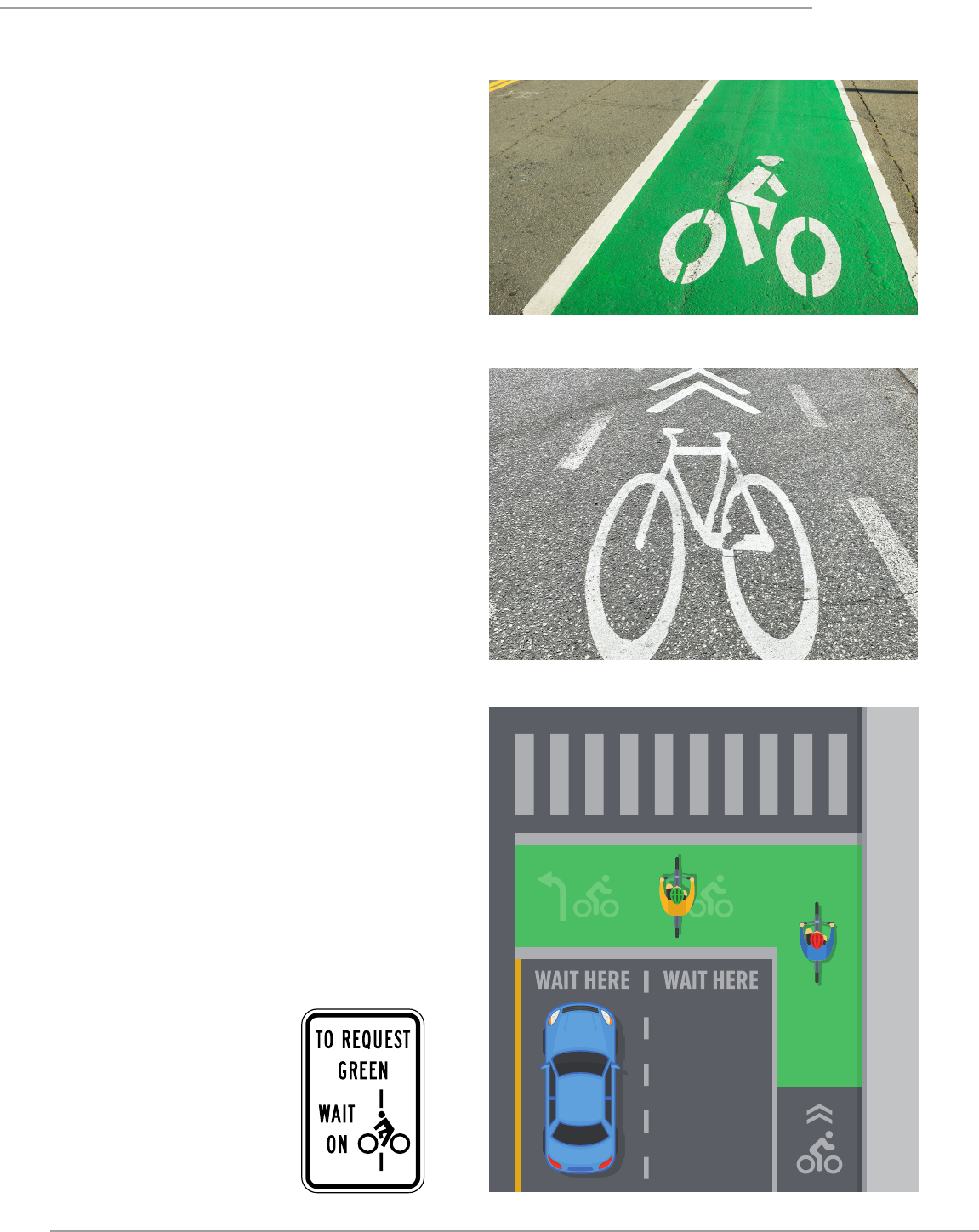
PAGE
16
CHAPTER 2
2.18 BICYCLE LANES AND
PAVEMENT MARKINGS
BICYCLE LANES
Bicycle lanes are portions of the roadway that are
intended for use by bicyclists and are marked by solid
white lines, along with bicycle pavement markings and
signs.
•
Some bike lanes may be further separated from
trafc through the use of double white lines,
curbs, posts, or planters.
•
Bicycle lanes may be lled with green paint
and motorists should pay close attention
and look for bicyclists before crossing green
pavement. Motorists should not stop on green
pavement. (See gure 2.9)
•
Motorists may only drive in bicycle lanes when
making turning movements and must look
carefully beside and behind their vehicle for
bicyclists and cross with care.
SHARED LANE MARKINGS
Shared lane pavement markings, also called “sharrows”
alert motorists of the presence of bicyclists, encourage
safe passing of bicyclists by motorists, and reduce
incidences of wrong-way bicycling and the potential
for door crashes. Unlike bike lanes, sharrows do not
designate a particular portion of the roadway for the
exclusive use of bicycles. (See gure 2.10)
BICYCLE BOXES
Bicycle boxes are pavement markings that are installed
to allow bicyclists a safe way to turn at a signalized
intersection. Bicycle boxes are solid green and have an
image of a bicyclist. They are located adjacent to the
crosswalk and they cover the entire width of the travel
lane. (See gure 2.11)
BICYCLE
DETECTOR SYMBOL
A symbol may be placed on the
pavement indicating the optimum
position for a bicyclist to activate/
trigger the trafc signal.
Figure 2.11: Bicycle boxes
Figure 2.10: Shared lane markings
Figure 2.9: Green bicycle lane
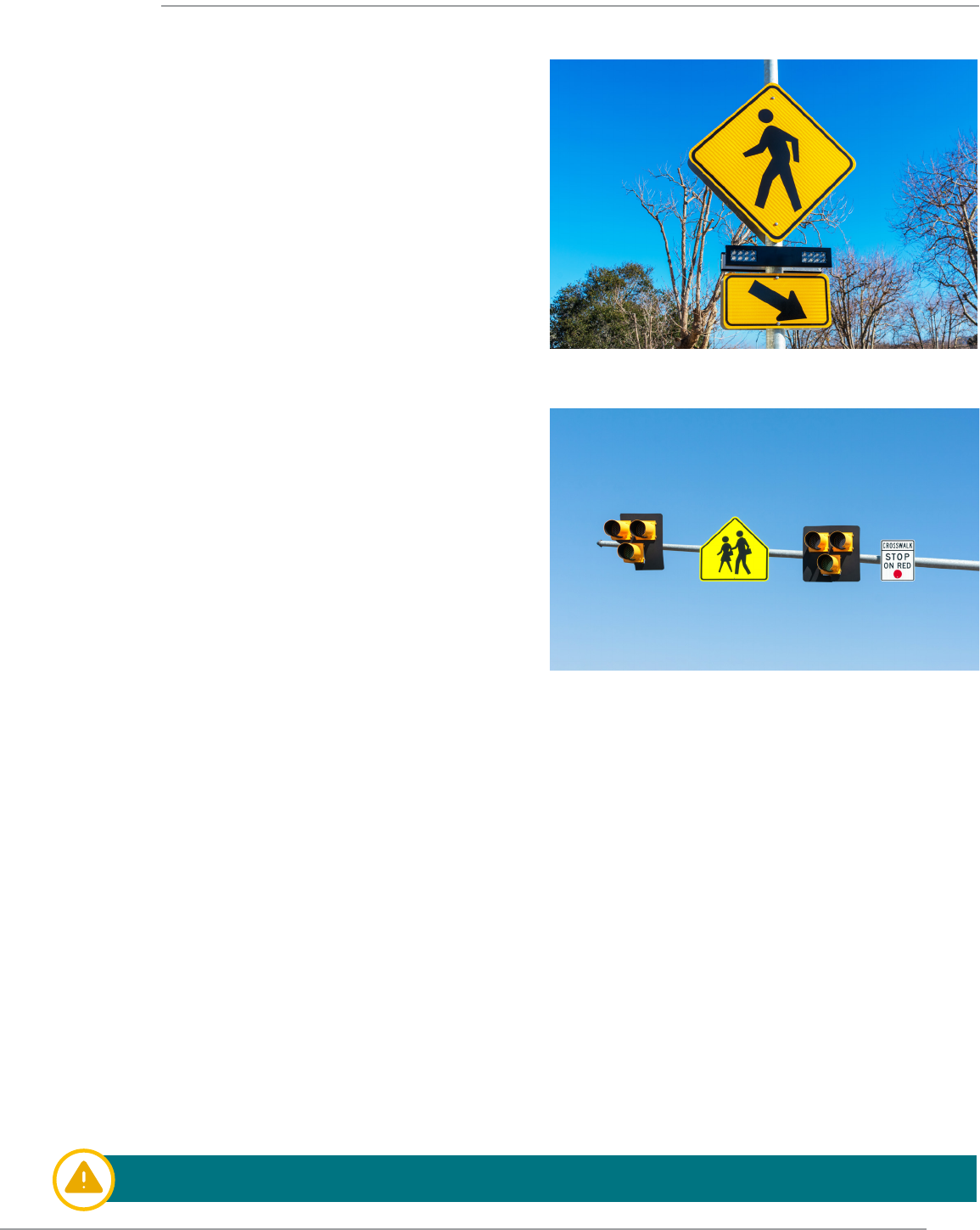
PAGE
17
CHAPTER 2
2.19 BICYCLE AND
PEDESTRIAN SIGNALS
RECTANGULAR RAPID
FLASHING BEACONS
Rectangular Rapid Flashing Beacons are manually
activated by pedestrians by a push button and are
often located at intersections without trafc signals
or at mid-block crosswalks. When activated, amber
lights ash in a rapid pattern. Motorists must stop
for pedestrians within the crosswalk and be alert for
pedestrians about to enter the crosswalk when the
beacon is ashing.
PEDESTRIAN HYBRID BEACONS
Pedestrian Hybrid Beacons allow pedestrians to safely
cross a roadway. These beacons operate only when
activated by a pedestrian. When all lights are dark,
motorists can proceed with caution. Once activated,
the bottom yellow light ashes, and motorists must
slow down. Then the bottom yellow light becomes
solid, and motorists must prepare to stop. Then the
top two red lights become solid, and motorists must
stop for pedestrians. After a short time, the top two red
lights will begin ashing. Motorists must stop if they
haven’t already done so, and may then proceed with
caution if the crosswalk is clear.
Figure 2.12: Rectangular rapid ashing beacon
Figure 2.13: Pedestrian hybrid beacon
2.20 SIGH T
-
IMPAIRED PEDESTRIANS
If your vehicle is approaching a person being led by a harnessed service animal, walking with a cane that is white
or white with a red tip, the person is likely visually impaired. Use extra caution to prevent injury to that person.
2.21 INTERSECTIONS
WHEN TO YIELD THE RIGHT
-
OF
-
WAY
Where vehicles or pedestrians are likely to meet one another and there are no signs or signals to regulate trafc,
there are rules that say who must yield the right-of-way. These rules tell drivers who goes rst and who must wait
in different trafc situations. The law says who must yield the right-of-way; it does not give anyone the right-of-
way. Regardless of who has the right-of-way, you should do everything you can to prevent striking a pedestrian or
another vehicle.
Be especially alert for bicyclists. While bicyclists and motorists must share the rights and responsibilities of using
the road, motorists should realize bicycle riders are very vulnerable in crashes. Therefore, motor vehicle drivers
should use good defensive driving skills to avoid collisions with bicyclists. Be ready to yield the right-of-way, even
at times the bicyclists should yield to you. They have no defense against a vehicle, so it is your responsibility as
a driver to watch out for them.
FAILURE TO YIELD THE RIGHT-OF-WAY IS THE #1 CAUSE OF TRAFFIC-RELATED FATALITIES IN IOWA.
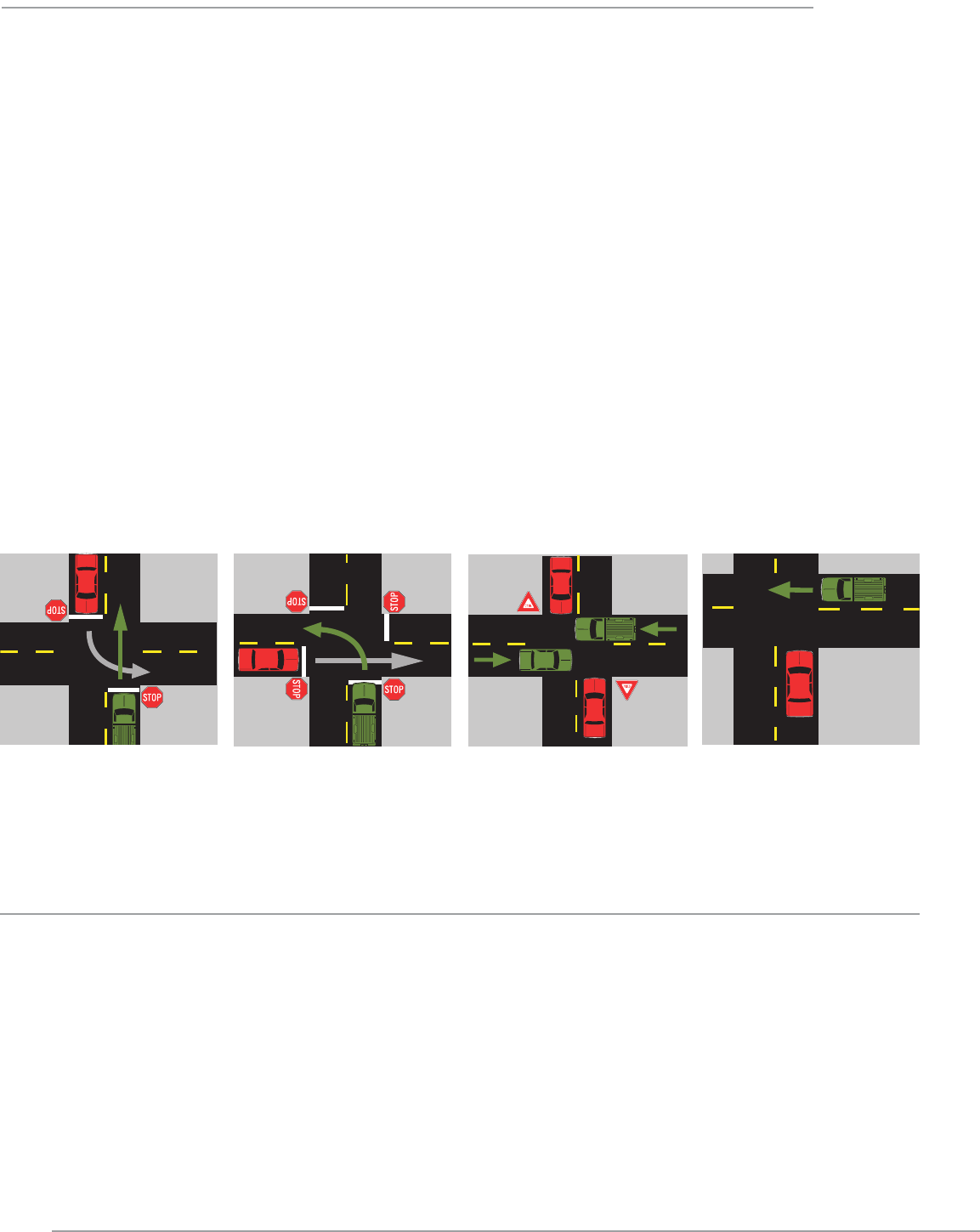
PAGE
18
CHAPTER 2
CONTROLLED
(
MARKED WITH SIGNS
)
INTERSECTIONS
The following right-of-way rules apply at intersections:
Figure 2.14b: All-way stop -
Two vehicles arrive at the
intersection at the same time.
The driver on the left (red
car) must yield to the driver
on the right (green car).
Figure 2.14c: Yielding to
cross-trafc - The red cars
must yield to the green cars.
Figure 2.14d: Uncontrolled
intersection - Two vehicles
arrive at the intersection at
roughly the same time. The
driver on the left (red car)
must yield to the driver on
the right (green car).
Figure 2.14a: Two-way stop
(cross trafc does not stop) -
Because the red car is turning
left into trafc, the red car
must yield to the green car
going straight.
2.22 EMERGENCY VEHICLES
Yield the right-of-way to a police vehicle, re engine, ambulance, or other emergency vehicle using a siren or air
horn, and/or red or blue ashing lights by taking the following actions:
•
Pull over to the right edge of the road, or as near to the right as possible, when you see or hear an emergency
vehicle approaching from any direction.
•
If you are in an intersection (including roundabouts), drive through the intersection before you pull over.
However, if you are on a street or high way separated by a median, and the emergency vehicle is on the other
side, you do not have to stop.
• Stay at least 500 feet behind any emergency vehicle using lights and sirens.
•
You must yield when you want to make a right
turn after stopping at a red light. Right turns on
red are permitted unless there is a sign prohibiting
them.
•
Drivers crossing a sidewalk, entering or exiting
a driveway, alley, or parking lot must yield to
pedestrians. It is illegal to drive on a sidewalk
except to cross it.
•
Drivers turning left must yield to oncoming cars
that are going straight ahead. (See gure 2.14a)
•
At an all-way stop, the driver reaching the
intersection rst gets to go rst (after coming to
a complete stop). For vehicles arriving at the same
time, the vehicle to the right gets to go rst. (See
gure 2.14b)
•
Drivers entering a road from a driveway, alley,
or roadside must yield to vehicles already on the
main road.
•
You must yield or stop for pedestrians in marked
or unmarked crosswalks.
UNCONTROLLED
(
UNMARKED
)
INTERSECTIONS
At an intersection where there is no stop sign or trafc signal, it’s the responsibility of all drivers to slow down and
approach carefully. All of the rules listed above that apply at a controlled intersection also apply at an uncontrolled
intersection. Extra caution should be used at uncontrolled intersections.
The red car must yield to approaching vehicles in these examples.
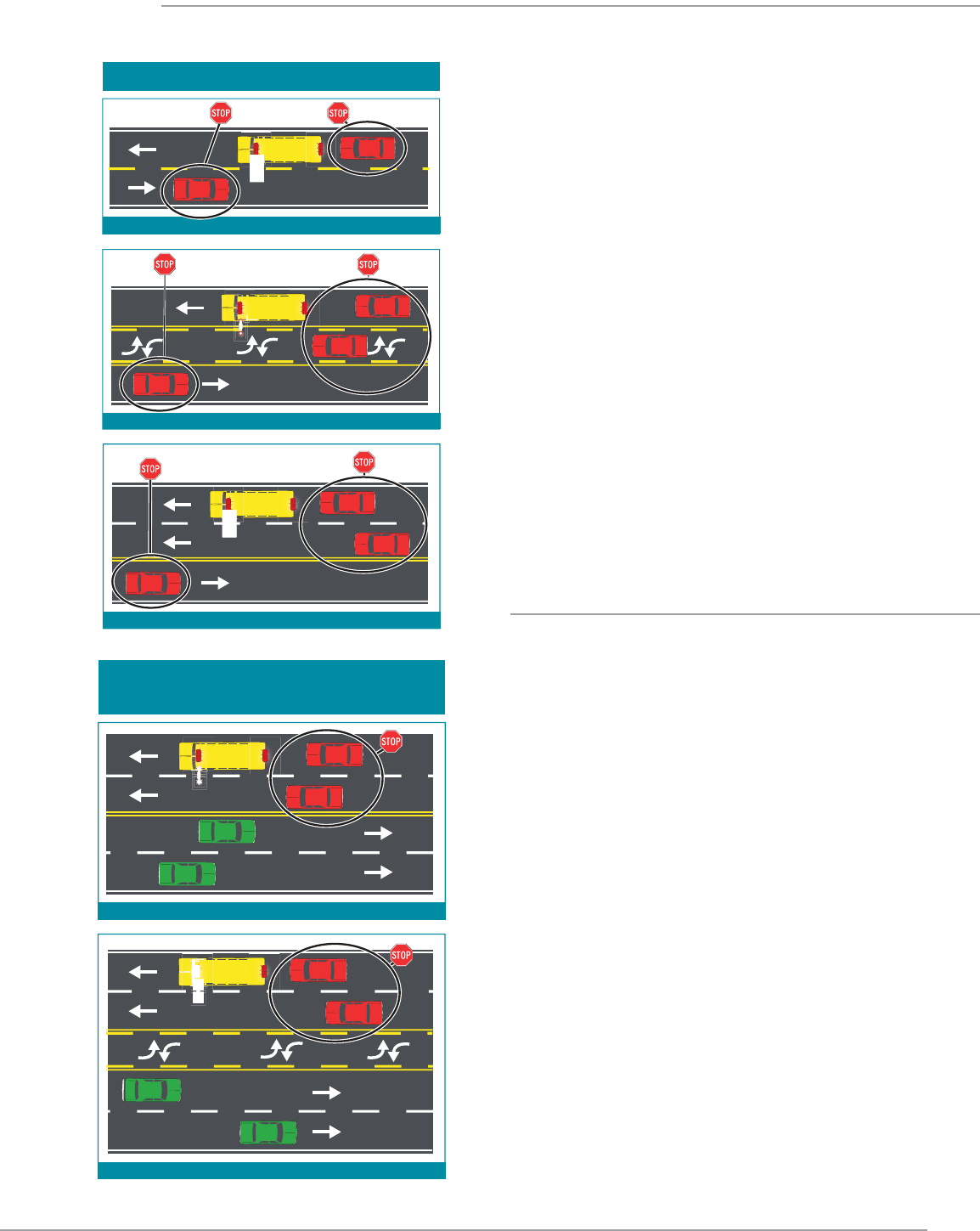
PAGE
19
CHAPTER 2
Three-lane highway
Two-lane highway with center turn lane
Two-lane highway
3 lanes or fewer: all vehicles must stop
Four-lane highway
Four-lane highway with center turn lane
4 lanes or more:
vehicles approaching from the rear must stop
Figure 2.15: Stopped school bus scenarios
2.23 SCHOOL BUSES
SCHOOL BUS SCENARIO 1
You are driving on a two- or three-lane road
Approaching the bus from the rear
When you see ashing red or amber warning lights, you are
not permitted to pass the school bus and should be prepared
to stop. Stop behind the school bus when the school bus
stops and the stop arm is extended. Stop no closer than
15 feet from the rear of the bus, and remain stopped until
the stop arm is retracted and the school bus starts moving
again. Proceed with caution.
Meeting the bus from the front
When you see amber warning lights ashing, you must slow
your vehicle to no more than 20 mph and be prepared to
stop. Stop in front of the school bus when the school bus
stops and its stop arm is extended. Remain stopped until
the stop arm is retracted. Proceed with caution.
Violating this law may result in your license being suspended
for up to 180 days.
SCHOOL BUS SCENARIO 2
You are driving on a road with four or more lanes
Approaching the bus from the rear
When approaching from the rear, the rules are the same as
for a two- or three- lane road. When you see ashing red
or amber warning lights, you are not permitted to pass the
school bus and should be prepared to stop. Stop behind the
school bus when the school bus stops and its stop arm is
extended. Stop no closer than 15 feet from the rear of the
bus, and remain stopped until the stop arm is retracted and
the school bus starts moving again. Proceed with caution.
Meeting the bus from the front
When meeting the bus in one of the opposite two lanes (or
more), you do not need to stop, even if the bus has stopped
with lights ashing and stop arm out. This is the only time
you may pass a school bus that is stopped and has its stop
arm extended.
Violating this law may result in your license being suspended
for up to 180 days.
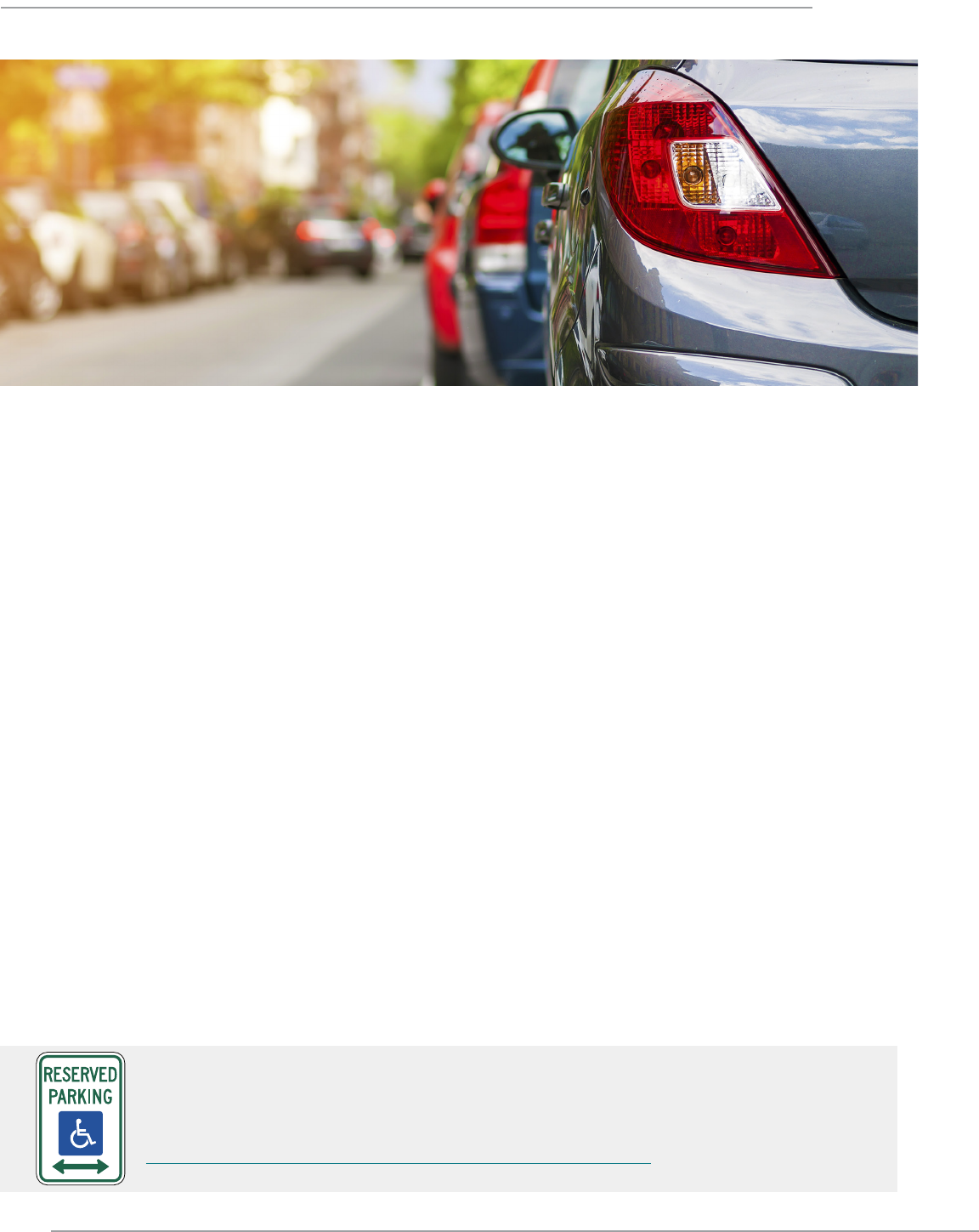
PAGE
20
CHAPTER 2
2.24 PA R K I N G
Drivers are responsible for making sure their vehicles do not become a hazard after they have been parked. When
parking, follow these guidelines.
• Park in a designated area, if possible.
•
If you must park on a roadway, park your
vehicle as far away from trafc as possible. If
there is a curb, park within 18 inches of the
curb or closer.
•
Park far enough from any travel lane to avoid
interfering with trafc.
•
Check trafc before you open the door. Get
out of the vehicle on the curb side if necessary.
2.25 PARKING NOT ALLOWED
There are many areas where you can’t park. Check for signs that prohibit or limit parking. Some parking restrictions
are indicated by colored curb markings. Do not park:
• On a crosswalk.
• In front of a public or private driveway.
•
On any bridge outside city limits or in highway
tunnels.
•
Alongside another stopped or parked car
(double parking).
•
Closer than ve feet from a re hydrant; or in
a designated hydrant red zone.
• Closer than 10 feet from a stop sign.
•
Closer than 20 feet from a re station entrance.
• Closer than 50 feet from a railroad crossing.
•
In “NO PARKING ZONES” which are usually
marked with signs, yellow painted curbs, or
pavement markings/lines.
• In an intersection.
• On a sidewalk.
• On interstates and highways
PARKING FOR PERSONS WITH DISABILITIES
Only park in a space reserved for persons with disabilities if you have a
Persons with Disabilities Parking Permit. For information on eligibility, visit
iowadot.gov/mvd/vehicleregistration/Persons-with-disabilities.

PAGE
21
CHAPTER 2
Figure 2.16: Steer It-Clear It law
2.26 APPROACHING STOPPED VEHICLES
IOWA’S MOVE OVER OR SLOW DOWN LAW
Iowa’s Move Over or Slow Down Law requires motorists to change lanes when approaching any of the following
stopped vehicles displaying ashing lights.
•
Any stopped emergency, tow, recovery, maintenance, construction, solid waste, or recycling collection vehicle
that has its ashing lights activated.
• Any stopped motor vehicle, including a passenger vehicle, that is continually displaying hazard lights.
If a lane change is not possible, prohibited by law, or unsafe, you must slow down and be prepared to stop. While
no speed is specied, it must be reasonable and proper for the existing conditions.
Violating this law may result in your license being suspended for up to one year.
2.27 STEER IT
-
CLEAR IT
If you are involved in a crash with no injuries, Iowa law requires that you move your vehicle out of the driving lanes
of trafc if the vehicle is operable and can be safely moved. For every minute a lane of trafc on the interstate is
blocked, the risk of a secondary crash increases by roughly 2.8 percent. (See gure 2.16)
MOVE CRASHED VEHICLES OUT OF THE DRIVING
LANES TO HELP PREVENT OTHER CRASHES AND
KEEP TRAFFIC FLOWING.
Every minute a lane is blocked the likelihood
of a secondary crash increases by 2.8%.
At around 30 minutes, the chance of a
secondary crash is very high.
Every minute a
lane is blocked
equals 4 minutes
of delay for trafc.
There are
approximately
55,000 crashes
in Iowa each year.
